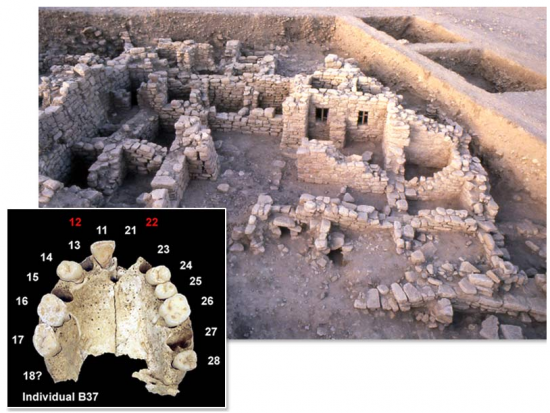Michael Balter
Source - http://news.sciencemag.org/sciencenow/2013/06/did-inbreeding-bind-early-farmer.html

Family ties that bind? A high percentage of farmers at 9500-year-old Basta in Jordan shared a genetic defect in which two incisors (red numbers) were missing. Credit: Archive of the Basta Joint Archeological Project; (inset) J. Kranzbhler/SIGN Project
Humans have been mating with their relatives for at least 10,000 years. That's the conclusion of a new study, which finds the earliest known evidence of deliberate inbreeding—including missing teeth—among farmers who lived in what is today southern Jordan. Although inbreeding over long periods can lead to a rise in genetic defects, the team concludes that it may have helped prehistoric peoples make the transition from hunting and gathering to village life.
Researchers agree that the best evidence for family ties is DNA. For example, ancient DNA from a group of Neandertal skeletons found in a Spanish cave showed that they belonged to the same extended family. But DNA often preserves poorly, especially at early farming sites from the so-called Neolithic period in the Near East where high temperatures and burials under house floors or in shallow graves easily degrade the genetic material. So some researchers have searched for signs of family relationships in the skeletons themselves, looking for rare anomalies that might suggest shared genetic heritage.
A team led by Kurt Alt, an anthropologist at the University of Mainz in Germany, examined the skeletons of individuals buried at the Neolithic site of Basta, in southern Jordan. Between about 9500 and 9000 years ago, up to 1000 early farmers lived there; the site was excavated in the 1980s and 1990s by an international team of archaeologists. At least 56 skeletons were found in one area, perhaps a graveyard.
In earlier research, Alt had identified more than 100 skeletal traits that can be used to determine family ties, most of which concern features of the teeth and jaws. Although inbreeding with very close relatives—such as between brothers and sisters, parents and children, or even cousins—boosts the incidence of genetic disease, mating with even more distant family members can increase the prevalence of traits that indicate family relationships. So his team set about looking at the upper jaws, or maxillae, of the Basta skeletons, which were well preserved in 28 individuals.
The search paid off: Ten skeletons, or about 36%, had a rare genetic anomaly called bilateral maxillary lateral incisor agenesis (MLIA), in which the outer incisors on both sides of the upper jaw are missing. (A normal mouth has four incisors on each jaw, two central ones and two outer or lateral ones.) MLIA occurred in both adult men and women, and an additional four children had very small incisors, which dental experts attribute to the same genetic defect that causes MLIA. This very high incidence of the defect is strong evidence for inbreeding among the Basta population, the team reports this month in PLOS ONE. The normal incidence of MLIA among today's populations rarely exceeds 4%.
The one known case that comes at all close to that of Basta, according to the team's literature search, is that of a small village in Switzerland where nearly 80% of the marriages were to family members over the past 230 years. In that village, 21% of the inhabitants had MLIA, and everyone with the genetic defect could trace their ancestry back to one couple that lived in the early 18th century.
The excavations at Basta suggested that the community was in regular contact with other Neolithic villages, making it unlikely that inbreeding was a necessity for these early farmers. Archaeologists found considerable evidence of trade and exchange with other sites, including raw materials such as turquoise and obsidian and finished artifacts such as mother-of-pearl amulets, stone rings, and stone tools similar to those found elsewhere in southern Jordan. Indeed, some archaeologists consider Basta to have been a center for stone tool manufacture and trade, due to the large number of tools found there.
The team also rejects the possibility that the Basta people were so full of genetic defects that others in nearby villages shunned them as mates. The missing incisors do not cause a major change in appearance because the gaps between the teeth close during development, and the team found no additional anomalies among the skeletons, nor any evidence that the individuals with MLIA were treated or buried differently. Alt adds that the data don't necessarily suggest incest, mating with very close family members such as parents or siblings.
Taken together, the team writes in its report, the findings strongly suggest that inbreeding was a deliberate choice at Basta, "the earliest evidence for a self-imposed exclusive mating system." The researchers point to possible signs of inbreeding, such as unusual suture patterns on skulls, at other Neolithic sites of similar age, such as the famous village of Çatalhöyük in Turkey, although no other site presents such a clear-cut case as Basta. If inbreeding was common during the early Neolithic, the team asserts, family ties could have been the cement that held at least some early farming communities together.
The findings are of "real significance" in understanding the social changes that took place as hunter-gatherers settled down and became farmers, says Trevor Watkins, an expert in Near East prehistory at the University of Edinburgh in the United Kingdom. They "delineate for the first time something of the nature of the close genetic relationships between members of a single, permanent community."
But Laurent Excoffier, a population geneticist at the University of Bern, says that the team has not entirely ruled out alternative explanations to deliberate inbreeding, such as so-called "founder effects"—in which a small group of people harbor a genetic trait that is retained at high numbers in the population, over many generations, due only to chance. The only way to distinguish these alternatives, Excoffier says, is by looking at the DNA.